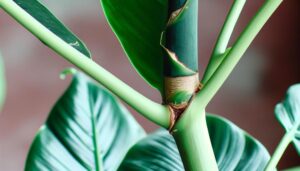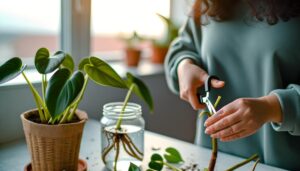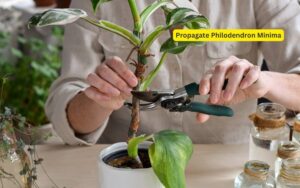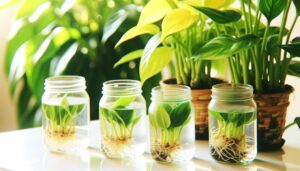Philodendron Adansonii Propagation
Propagating Philodendron Adansonii requires systematic preparation and careful execution. Begin by selecting vigorous, disease-free parent plants.
Utilize sterilized pruning shears to make clean cuts just below a node, choosing stems with two or three nodes. Place cuttings immediately in distilled water or a well-draining soil mix, ensuring consistent moisture and indirect light.
Maintain a humid environment with temperatures between 65-75°F (18-24°C). Regular water changes or soil moisture checks are essential to prevent rot.
Use balanced, water-soluble fertilizers monthly. These steps will lead to healthy root development and robust growth for your new plants.
For an in-depth guide, continue with our systematic approach.
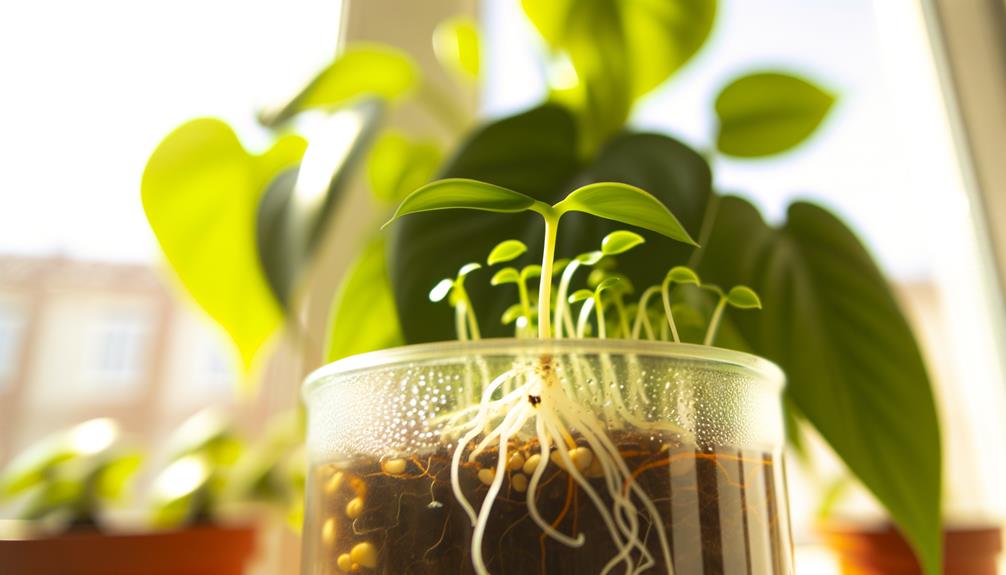
Key Takeaways
- Choose healthy parent plants with strong, disease-free stems for higher propagation success.
- Use sterilized pruning shears to cut just below a node at a 45-degree angle.
- Submerge cuttings with at least two nodes in distilled water, changing water every 3-5 days.
- Plant cuttings in well-draining potting mix with rooting hormone, maintaining consistent moisture and indirect light.
- Ensure a stable temperature range of 65-75°F and humidity levels between 60-70% for optimal growth.
Choosing Healthy Parent Plants
Choosing vigorous and disease-free parent plants is crucial for successful Philodendron Adansonii propagation. Healthy specimens display strong growth, lush green leaves, and are free from pests and diseases. Prioritize plants with sturdy, unblemished stems and avoid those displaying signs of yellowing, wilting, or fungal infections.
Evidence indicates that using healthy parent plants greatly increases the likelihood of successful rooting and growth in cuttings. Methodically examine each plant, focusing on leaf texture, color, and overall health. A thorough visual and tactile assessment guarantees the selection of top candidates, thereby improving propagation success rates.
Maintaining parent plants in prime condition minimizes the risk of spreading pathogens and maximizes genetic strength in propagated offspring.
Gathering Necessary Tools
To guarantee successful propagation of Philodendron Adansonii, it is essential to gather the appropriate cutting tools and select an ideal rooting medium. Sharp, sterilized pruning shears are necessary to obtain clean cuttings, thereby reducing the risk of infection.
Additionally, choosing between soil, water, or sphagnum moss as a rooting medium can greatly affect root development and overall plant health.
Essential Cutting Tools
A successful Philodendron Adansonii propagation necessitates a precise set of cutting tools. These tools include sanitized scissors or pruning shears, a hygienic working surface, and rooting hormone. Sanitization is crucial to prevent pathogen transmission, which could jeopardize cutting viability. Using isopropyl alcohol for sanitization ensures effective microbial elimination.
The cutting tools should be sharp to facilitate a clean cut, reducing tissue damage and promoting excellent healing and root development. A clean working surface further reduces contamination risks. Rooting hormone, while optional, significantly boosts root formation by providing essential growth regulators.
Adherence to these systematic practices guarantees a higher success rate in propagation, minimizing potential complications and nurturing a flourishing Philodendron Adansonii.
Rooting Medium Choices
Understanding the various rooting medium choices is crucial to achieving successful propagation of Philodendron Adansonii. The most commonly utilized mediums include water, sphagnum moss, and perlite.
Water propagation is often favored for its simplicity, allowing clear observation of root development.
Sphagnum moss, known for its moisture retention and aeration properties, reduces the risk of rot and promotes robust root formation.
Perlite, a volcanic glass, offers excellent drainage and aeration, minimizing the likelihood of root diseases.
Selecting an appropriate rooting medium depends on individual comfort level and environmental conditions. Gathering the necessary tools, such as clean jars for water, sterilized sphagnum moss, or perlite-filled containers, is essential.
This evidence-based approach ensures optimal rooting conditions, thereby improving propagation success.
Cutting the Stem
When cutting the stem for propagation, it is important to select healthy, disease-free stems to guarantee successful rooting. Employing proper cutting techniques, such as using sterilized tools and making clean, angled cuts just below a node, greatly enhances the likelihood of robust growth.
This systematic approach minimizes plant stress and promotes best propagation outcomes.
Choosing Healthy Stems
Selecting robust stems is crucial for successful propagation of Philodendron Adansonii. Healthy stems should be visually examined for signs of strength and liveliness. Ideal stems are green, firm, and free from any signs of disease or pest infestation.
Nodes, the points on the stem where leaves and roots develop, should be visibly healthy and well-defined. Evidence-based studies show that stems with at least two or three nodes have higher propagation success rates.
Additionally, stems should be moderately mature; overly young or old stems may not root as effectively. Systematically selecting such stems enhances the likelihood of strong root development and overall plant health, paving the way for successful propagation outcomes.
Proper Cutting Techniques
To achieve best propagation success, precise cutting techniques must be employed when severing the selected Philodendron Adansonii stems. Utilizing sterilized tools, such as pruning shears or a sharp knife, is crucial to prevent infection. Make sure that each cut is made just below a node, as this is where root development initiates. A 45-degree angle cut enhances the surface area, promoting peak nutrient absorption.
Key steps include:
- Disinfecting Tools: Use alcohol or bleach solution to sanitize cutting instruments.
- Identifying Nodes: Cut below a node where a leaf and aerial root meet.
- Angled Cuts: Create a 45-degree angle to maximize rooting potential.
- Immediate Water Placement: Place cuttings in water right away to avoid air embolism.
- Monitoring: Regularly inspect for signs of rot or disease.
Rooting in Water
Rooting Philodendron Adansonii cuttings in water offers an efficient and observable method to initiate the propagation process. Begin by selecting a healthy cutting with at least two nodes and a few leaves.
Submerge the cut end in a clear container filled with distilled or filtered water, ensuring one node remains underwater. Place the container in indirect sunlight to prevent algal growth and promote root development.
Change the water every 3-5 days to maintain oxygen levels and prevent bacterial buildup. Typically, root emergence occurs within 2-4 weeks, at which point roots should be at least 2-3 inches long before transplanting.
This method allows for continuous monitoring of root progress, facilitating timely intervention if issues arise.
Rooting in Soil
For those preferring a more traditional method, propagating Philodendron Adansonii cuttings in soil involves a systematic approach to guarantee successful root development.
Initiate by selecting a healthy cutting with at least two nodes. Utilize a rooting hormone to enhance root formation, then plant the cutting in a well-draining potting mix.
Maintain consistent moisture without waterlogging, and place the pot in a warm, indirect light environment. Ensuring proper ventilation mitigates fungal growth.
Choose a healthy cutting with a minimum of two nodes.
Apply rooting hormone to stimulate root growth.
Plant cutting in well-draining potting mix.
Keep soil consistently moist but avoid waterlogging.
Position in a warm location with indirect light and good airflow.
Following these steps will foster effective root establishment.
Transplanting New Plants
Once the Philodendron Adansonii cuttings have developed a robust root system, it is prudent to transplant them into individual pots to further support their growth.
Begin by selecting pots with adequate drainage holes to prevent waterlogging, which can lead to root rot.
Fill the pots with a well-draining potting mix, ideally a blend of peat moss, perlite, and orchid bark, to mimic their natural habitat.
Gently remove the cuttings from their initial rooting medium, taking care not to damage the delicate roots.
Position each cutting in the center of its new pot, and fill in the surrounding space with the potting mix, ensuring that the roots are fully covered.
Care for New Growth
To secure the healthy growth of newly transplanted Philodendron Adansonii, it is essential to provide ideal light, humidity, and watering conditions. Best care involves maintaining the right balance of environmental factors to promote robust development. Key considerations include:
- Light: Position the plant in bright, indirect light to encourage vigorous growth while preventing leaf burn.
- Humidity: Sustain humidity levels between 60-70% to replicate the plant’s natural tropical habitat.
- Watering: Keep the soil consistently moist but well-drained to avoid root rot.
- Temperature: Guarantee a stable temperature range of 65-75°F (18-24°C) to foster healthy metabolic processes.
- Nutrients: Apply a balanced, water-soluble fertilizer monthly during the growing season to support nutrient uptake.
Following these guidelines will promote the flourishing of new growth.
Troubleshooting Common Issues
Identifying and addressing common issues in Philodendron Adansonii propagation guarantees the long-term health and significance of the plant.
Root rot, often caused by overwatering or inadequate drainage, is a primary concern. Make sure pots have drainage holes and use a well-aerated soil mix.
Yellowing leaves may indicate either nutrient deficiency or overexposure to direct sunlight. Adjust fertilization schedules and relocate the plant to an area with indirect light.
Pest infestations, such as spider mites or aphids, require immediate intervention using insecticidal soap or neem oil.
Maintaining peak humidity levels (50-60%) mitigates leaf browning and promotes vigorous growth.
Regular monitoring and timely corrective actions are crucial to overcoming these challenges and ensuring successful propagation.
Conclusion
Propagating Philodendron adansonii involves a meticulous process requiring precision and patience. By selecting robust parent plants, utilizing appropriate tools, and adhering to systematic rooting techniques, one can achieve successful propagation.
However, one must not overlook the irony in the meticulous care lavished upon a plant that thrives in the wild with utter indifference. Consequently, while the pursuit of horticultural mastery is commendable, it serves as a reminder of nature’s inherent resilience and humanity’s penchant for complexity.

